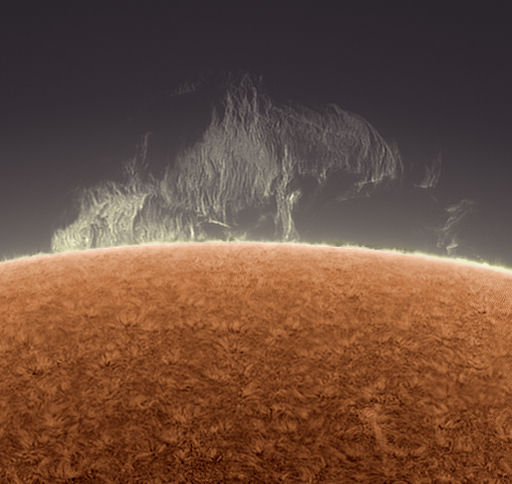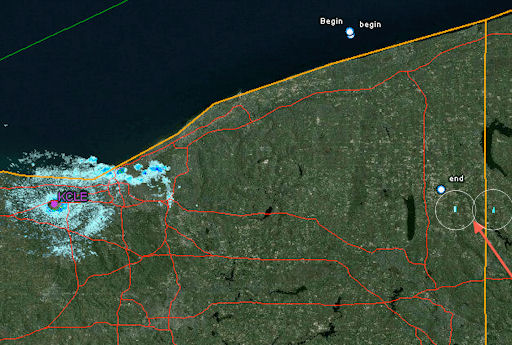Metallic photos of the sun by renowned photographer Greg Piepol bring together the best of art and science. Buy one or a whole set. They make a stellar gift. | | |
SPACECRAFT SEES CME ENGULF EARTH: For the first time, a spacecraft far from Earth has turned and watched a solar storm engulf our planet. The movie, released today during a NASA press conference, has galvanized solar physicists, who say it could lead to important advances in space weather forecasting. Get the full story from Science@NASA.
DELICATO: With two big sunspots turning toward Earth and a variety of prominences dancing around the solar limb, the sun is attracting the attention of amateur astronomers. Alan Friedman sends this report from Buffalo, New York: "The activity on the sun today was so diverse in intensity and character I was reminded of movements in a symphony. This very massive prominence (pictured below) was so very faint--almost invisible when others circling the limb were properly exposed. It's delicate tendrils inspired the name Delicato."

In Falmouth, Maine, photographer John Stetson turned his solar telescope toward sunspot group 1271 and found it seething. "The active region is bright and crackling, surrounded by long, twisting filaments of magnetism that seem poised to produce some powerful flares," he says. Indeed,NOAA analysts note that the sunspot has a "beta-delta-gamma" magnetic field that harbors energy for X-class explosions.
more images: from Jesús Carmona de Argila of Madrid (SPAIN); from Ferenc Schnellbach of Budapest, Hungary ; from Rogerio Marcon of Campinas SP Brasil; from Cai-Uso Wohler of Bispingen, Germany; from Stefano De Rosa of Isola d'Elba (Italy); from Francisco A. Rodriguez of Cabreja Mountain Observatory, Canary Islands
METEORITE ALERT: Bill Cooke, head of NASA's Meteoroid Environment Office has issued a meteorite alert for residents of small towns east of Cleveland, Ohio. There could be space rocks on the ground waiting to be found. "On August 8 at 1:22 Eastern Daylight Time, all-sky cameras belonging to the Southern Ontario Meteor Network detected a fireball entering the atmosphere 54 miles above Lake Erie (80.944 W, 41.945 N), moving SSE at 25 km/s (55,900 mph). There is high confidence that this meteor produced meteorites." For one thing, the debris appears to have produced echoes from KCLE's doppler radar in Cleveland; note the circled reflections:

"The deep atmospheric penetration of this fireball combined with its deceleration and doppler radar echo strongly suggests a fall somewhere in the countryside east of Clevelend," continues Cooke. Pushpins in this Google map show some possible fall locations based on different assumptions about the meteorite's speed and mass. There could be debris anywhere in the countryside around the Ohio towns of Warren, Kinsman, and Hermitage. Readers who find a candidate meteorite are encouraged to contact the Meteoroid Environment Office for further instructions.
August 2011 Aurora Gallery
[previous Augusts: 2010, 2009, 2008, 2007, 2006, 2005, 2004, 2003, 2002]
2011 Noctilucent Cloud Gallery
[previous years: 2003, 2004, 2005, 2006, 2007, 2008, 2009]

